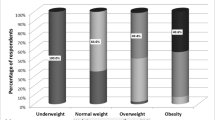Abstract
Purpose
The purpose of this study was to examine the differences among actual body size, perceived body size, and ideal body size in overweight and obese young adult women.
Methods
Actual body size was assessed by body mass index (BMI), while self-perceived and ideal body sizes were assessed by the Body image assessment tool-body dimension. Descriptive statistics were calculated and analysis of variance (ANOVA) was performed on actual BMI as a function of perceived BMI.
Results
Of the 42 participants included in the study, 12 were overweight (25 ≤ BMI < 30), 18 were obese 1 (30 ≤ BMI < 35), and 12 were obese 2 (35 ≤ BMI ≤ 39.48). The mean ideal body size of participants was 25.34 ± 1.33. Participants in general perceived their body size (BMI: 35.82 ± 1.06) to be higher than their actual body size (32.84 ± 0.95). Overweight participants had a significantly higher mean body size misperception than obese 2 individuals (µ dif = −6.68, p < .001).
Conclusion
Perception accuracy of body size differs in women by BMI. Weight loss programs need to be tailored to consider body size misperception in order to improve treatment outcomes for overweight and obese young women.
Similar content being viewed by others
References
Grogan S (2006) Body image and health: contemporary perspectives. J Health Psychol 11(4):523–530. doi:10.1177/1359105306065013
Bucchianeri MM, Arikian AJ, Hannan PJ, Eisenberg ME, Neumark-Sztainer D (2013) Body dissatisfaction from adolescence to young adulthood: findings from a 10-year longitudinal study. Body Image 10(1):1–7. doi:10.1016/j.bodyim.2012.09.001
Leontiadis GIH, Howden CW (2010) Body size misperception: a novel determinant in the obesity epidemic. Arch Int Med 170(18):1695–1700. doi:10.1001/archinternmed.2010.314
Duncan DT, Wolin KY, Scharoun-Lee M, Ding EL, Warner ET, Bennett GG (2011) Does perception equal reality? Weight misperception in relation to weight-related attitudes and behaviors among overweight and obese US adults. Int J Behav Nutr Phys Act 8:20. doi:10.1186/1479-5868-8-20
Paul T, Sciacca R, Bier M, Rodriguez J, Song S, Giardina E-G (2015) Size misperception among overweight and obese families. J Gen Int Med 30(1):43–50. doi:10.1007/s11606-014-3002-y
Docteur A, Urdapilleta I, Defrance C, Raison J (2010) Body perception and satisfaction in obese, severely obese, and normal weight female patients. Obesity 18(7):1464–1465. doi:10.1038/oby.2009.418
Dorsey RR, Eberhardt MS, Ogden CL (2009) Racial/ethnic differences in weight perception. Obesity 17(4):790–795. doi:10.1038/oby.2008.603
Fallon EA, Harris BS, Johnson P (2014) Prevalence of body dissatisfaction among a United States adult sample. Eat Behav 15(1):151–158. doi:10.1016/j.eatbeh.2013.11.007
Mintem GC, Gigante DP, Horta BL (2015) Change in body weight and body image in young adults: a longitudinal study. BMC Public Health 15(1):222. doi:10.1186/s12889-015-1579-7
Bucchianeri MM, Neumark-Sztainer D (2014) Body dissatisfaction: an overlooked public health concern. J Public Ment Health 13(2):64–69. doi:10.1108/JPMH-11-2013-0071
Neumark-Sztainer D, Paxton SJ, Hannan PJ, Haines J, Story M (2006) Does body satisfaction matter? Five-year longitudinal associations between body satisfaction and health behaviors in adolescent females and males. J Adolesc Health 39(2):244–251. doi:10.1016/j.jadohealth.2005.12.001
Sonneville KR, Calzo JP, Horton NJ, Haines J, Austin SB, Field AE (2012) Body satisfaction, weight gain and binge eating among overweight adolescent girls. Int J Obes 36(7):944–949. doi:10.1038/ijo.2012.68
Rayner KE, Schniering CA, Rapee RM, Taylor A, Hutchinson DM (2013) Adolescent girls’ friendship networks, body dissatisfaction, and disordered eating: examining selection and socialization processes. J Abnorm Psychol 122(1):93–104. doi:10.1037/a0029304
Stice E, Marti CN, Durant S (2011) Risk factors for onset of eating disorders: evidence of multiple risk pathways from an 8-year prospective study. Behav Res Ther 49(10):622–627. doi:10.1016/j.brat.2011.06.009
Gregory CO, Blanck HM, Gillespie C, Maynard LM, Serdula MK (2008) Health perceptions and demographic characteristics associated with underassessment of body weight. Obesity 16(5):979–986. doi:10.1038/oby.2008.22
Jáuregui-Lobera I, Ezquerra-Cabrera M, Carbonero-Carreño R, Ruiz-Prieto I (2013) Weight misperception, self-reported physical fitness, dieting and some psychological variables as risk factors for eating disorders. Nutrients 5(11):4486. doi:10.3390/nu5114486
Hernan AL, Versace VL, Laatikainen T, Vartiainen E, Janus ED, Dunbar JA (2014) Association of weight misperception with weight loss in a diabetes prevention program. BMC Public Health 14(1):93. doi:10.1186/1471-2458-14-93
Cha E, Umpierrez G, Kim KH, Bello MK, Dunbar SB (2013) Characteristics of American young adults with increased risk for type 2 diabetes: a pilot study. Diabetes Educ 39(4):454–463. doi:10.1177/0145721713486199
Cha E, Kim KH, Lerner HM, Dawkins CR, Bello MK, Umpierrez G, Dunbar SB (2014) Health literacy, self-efficacy, food label use, and diet in young adults. Am J Health Behav 38(3):331–339. doi:10.5993/ajhb.38.3.2
Evans E, Boothroyd L, Muscariello E, Stephan B, Nasti G, Colantuoni A, Siervo M (2015) Lower weight loss expectations and healthier eating attitudes in older overweight and obese women attempting weight loss. Clin Obes 5(3):136–144. doi:10.1111/cob.12093
Ohara K, Kato Y, Mase T, Kouda K, Miyawaki C, Fujita Y, Okita Y, Nakamura H (2014) Eating behavior and perception of body shape in Japanese university students. Eat Weight Disord 19(4):461–468. doi:10.1007/s40519-014-0130-7
Gardner RM, Jappe LM, Gardner L (2009) Development and validation of a new figural drawing scale for body-image assessment: the BIAS-BD. J Clin Psychol 65(1):113–122. doi:10.1002/jclp.20526
Rancourt D, Leahey TM, LaRose JG, Crowther JH (2015) Effects of weight-focused social comparisons on diet and activity outcomes in overweight and obese young women. Obesity 23(1):85–89. doi:10.1002/oby.20953
Thompson JK, Stice E (2001) Thin-ideal internalization: mounting evidence for a new risk factor for body-image disturbance and eating pathology. Curr Dir Psychol Sci 10(5):181–183. doi:10.1111/1467-8721.00144
Acknowledgments
We acknowledge the National Institute of Nursing Research (K01NR012779, PI: E.S. Cha), Emory University (University Research Committee and Atlanta Clinical & Translational Science Institute (ACTSI) collaborative grant), and the Atlanta Clinical and Translational Science Institute (UL1 RR025008) for their support of this study.
Author information
Authors and Affiliations
Corresponding authors
Ethics declarations
Conflict of interest
We have no potential conflict of interest.
Ethical approval
This study was approved by the Emory University Institutional Review Board in Atlanta, Georgia.
Informed consent
Informed consent was obtained from all participants in the study.
Rights and permissions
About this article
Cite this article
Lerner, H.M., Klapes, B., Mummert, A. et al. Body size perception and ideal body size in overweight and obese young adult women. Eat Weight Disord 21, 487–492 (2016). https://doi.org/10.1007/s40519-015-0239-3
Received:
Accepted:
Published:
Issue Date:
DOI: https://doi.org/10.1007/s40519-015-0239-3




